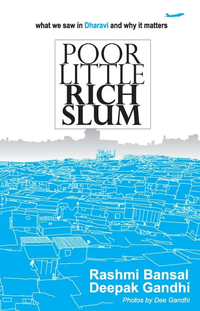#PoorLittleRichSlum
Poor Little Rich Slum
One little two little three little Indians, four little five little six little Indians, seven little eight little nine little Indians. One million little Indian entrepreneurs.
These are the stories of the little people who make up the Big Idea
Read More..
Ratings
Likes
Reviews
None
9 years ago
Poor Little Rich Slum, to me is like a vitamin pill
Poor Little Rich Slum, the latest from Rashmi Bansal and Deepak Gandhi, begins with the old poem, ‘It was six men of Indostan…Who went to see the Elephant’ Unlike those blind men of Indostan however, the authors of this book, in my opinion have succeeded in painting a picture of the Elephant with better clarity and resolution. Poor Little Rich Slum is an out and out account of Dharavi (dhaa-raa-vi), Asia’s largest slum, as it stands credited and the grounds of Slumdog Millionaire as it was further popularized as. The book has the feel and effect of a handycam taping a day in Dharavi, with a voiceover by the authors that steps aside occasionally to let the locals talk. Focusing on the Dharavi Redvelopment Project at the outset, the authors proceed to obtain a critical opinion for themselves on what goes into life at Dharavi and why all this fuss about DRP anyway. What follows is a glimpse into the reality that has lingered over Dharavi ever since it all began, one that leaves you amazed, confused, touched and outright speechless in the end. With my usual judging a book by the cover exercise, I anticipated this account would either be a story of accomplishment – Check it out, we did a study in a well known slum; or a manuscript for one of those documentaries that Social workers come up with – dark, questioning and uncomfortable. The fact is, it was both, but without being cocky and arrogant like the former or depressing and blameful like the latter. This was an honest account of things as they are, from a group of people who chose to venture into the study with as much nervousness as any individual that chooses to do something right because he believes in it. The account takes us into the lives and existence of Dharavi folk, natives and immigrants alike. It speaks mostly of how, under what we see as grime and slush, are living beings who do not seem to share the same world as us, but sustain in a dynamic world of their own; with the same kind of dreams and aspirations as ours, but deprived of an easy entry ticket. To the urban eye Dharavi sounds and appears lost. Listen to the voices in this book and you’ll know you couldn’t have been more wrong. For Dharavi is a huge pulsating heart, that beats with the spirit of its people, a thousand success stories running through its spine. Every story presented, reeks of optimism and survival of the human spirit through the toughest of times; hardwork is a habit at Dharavi and it is not considered an imposition, which is what makes its inmates an enigma. What you make out of the stories in this book are entirely up to you because whatever I might conclude would only be subjective. But in the stricter view of a book review:What worked for me: 1. Tiny chapters with delicious pictures at every turn and spaced out printing. 2. Simplicity of narration that didn’t try to wallow in sorrow, blame urban dwellers or delve into the poetic for effect. 3. The beautiful pictures by Dee Gandhi.Originally posted by https://www.blogger.com/profile/14103024728361258049
 Like
Like
 DisLike
DisLike
Popularity
Ranks
This #hashtag is not ranked yet.

